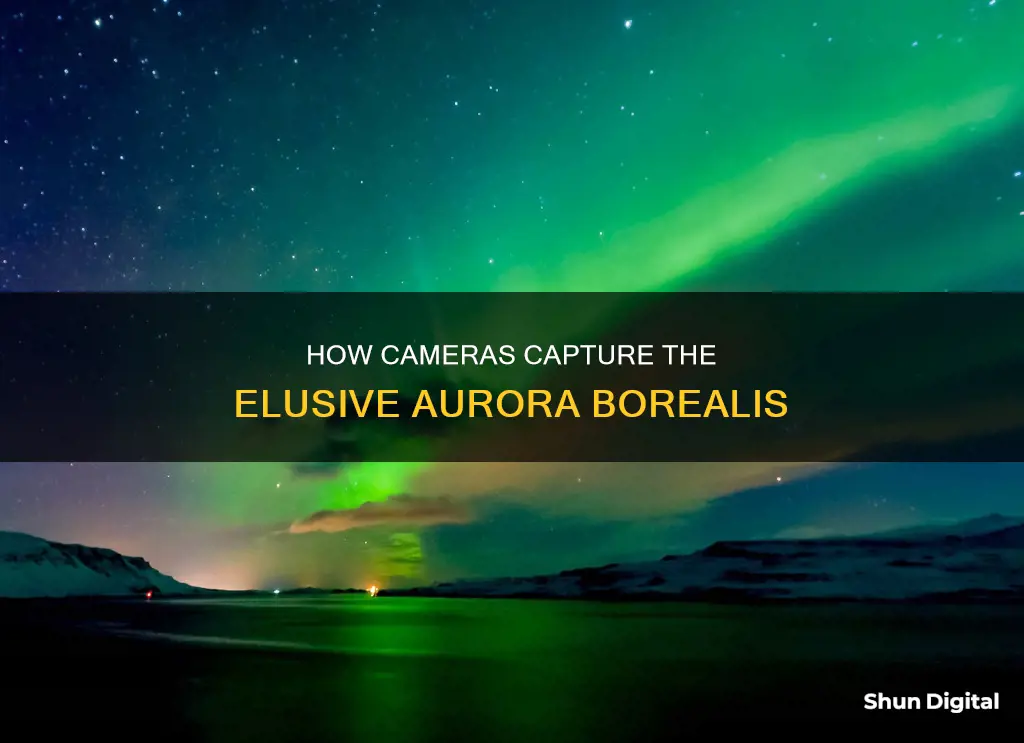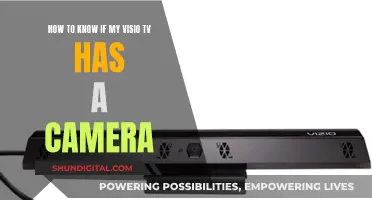
The aurora borealis, or Northern Lights, is a spectacular natural light show visible at certain times in the Arctic Circle. This phenomenon is caused by the interaction of the solar wind with the Earth's atmosphere, and the resulting collisions of charged particles from the sun with gases in the Earth's atmosphere emit light at various wavelengths, creating vibrant displays of colour in the sky. The colours visible depend on the type of gas particles involved and the altitude at which the collisions occur. While this spectacle can be observed with the naked eye, cameras are able to capture a wider spectrum of colours and a more dynamic range of vision in the dark. This is because human eyes have a limited ability to see colour in low-light conditions, whereas cameras can pick up on these colours through long exposures and high ISO settings.
| Characteristics | Values |
|---|---|
| Human eye limitations | Human eyes can't see the relatively "faint" colors of the aurora at night. |
| Human eye structure | Our eyes have cones and rods – the cones work during the day and the rods work at night. |
| Human eye cone cells | Cone cells detect color in bright light and are high resolution. |
| Human eye rod cells | Rod cells can detect much fainter light at night but only see in black and white and shades of gray. |
| Camera advantage | DSLR camera sensors don't have the same limitations as the human eye. |
| Camera advantage | Long exposure times and high ISO settings of modern cameras mean the camera sensor has a much more dynamic range of vision in the dark than humans. |
| Camera advantage | Cameras can pick up ultraviolet and infrared light, which is not visible to the human eye. |
| Camera advantage | Cameras can pick up more colors than the human eye. |
| Camera advantage | Cameras can pick up motion better than the human eye. |
| Camera advantage | Cameras can use timelapse to speed up perception of motion. |
| Camera advantage | Cameras can use video to capture the aurora. |
| Camera advantage | Cameras can use high ISO, very slow exposures, and the timelapse effect to capture the aurora better than the human eye. |
| Human eye advantage | The human eye can sometimes see more color than a camera in certain conditions, such as during a high-level aurora event. |
| Human eye advantage | The human brain can rebuild an image in memory that is richer and more full of colors than what was actually seen. |
What You'll Learn

Cameras are more sensitive to light wavelengths than the human eye
As light becomes less abundant, the red sensors in the eye become less effective. At night, the eye is limited to mainly black and white sensors, picking up on tones, contrast, and textures. This is why the human eye views the Northern Lights in black and white or shades of grey.
DSLR camera sensors, however, do not have this limitation. The long exposure times and high ISO settings of modern cameras mean the camera sensor has a much more dynamic range of vision in the dark than the human eye. Cameras can also pick up on ultraviolet and infrared light, which is invisible to the human eye.
Unsecured Cameras: Is Watching a Crime?
You may want to see also

Cameras can pick up ultraviolet and infrared light
Cameras, especially DSLRs, are able to capture ultraviolet and infrared light, which is invisible to the human eye. This is because the human eye has cones and rods – the cones work during the day and the rods work at night. While the cones are high-resolution and detect colour in bright light, the rods can only detect black, white, and shades of grey at night.
Ultraviolet cameras are devices designed to record images in the ultraviolet part of the electromagnetic spectrum. This part of the spectrum is invisible to the human eye, so any captured images are digitally converted into colours that we can see. UV photography is used for scientific, medical, or artistic purposes, as well as to reveal the deterioration of artworks or structures. It is also employed in forensics and medicine to detect skin disorders, injuries, bruises, and scars.
DSLR camera sensors don't have the same limitations as the human eye. When coupled with long exposure times and high ISO settings, the camera sensor has a much more dynamic range of vision in the dark. The camera will ALWAYS see more than our eyes can. The light our eyes see is very different from what our cameras can assemble. The camera can pick up so much more.
The colours of the aurora are determined by the type of gas particles involved in collisions with charged particles from the sun and the altitude at which these collisions occur. The human eye is not as sensitive to these wavelengths as cameras are. Using a long exposure on your camera allows more light into the lens, providing you with the colours that you see in photographs and videos.
Public Camera Feeds: Are They Legal to Watch?
You may want to see also

Human eyes have limited night vision
As light becomes less abundant, the red sensors in our eyes switch off. Our night vision is limited when it comes to colour, and we are left with mainly black and white sensors, picking up on tones, contrast, and textures. Green is the most sensitive colour at night and will pick up the most colour. Our brain, meanwhile, uses its amplifier, and our understanding that the sky is blue, means that when gazing at the night sky, we will mainly see green or blue.
During the day, our eyes are incredibly fast at adjusting to dynamic range and light intensity. However, at night, it takes time for our eyes to adjust to the amount of light available. It takes about an hour for our eyes to adjust to dark skies properly. To adjust properly, refrain from using any LED lights or looking at backlit screens such as phones or laptops, as these disrupt our eyes' ability to adjust.
The human eye views the Northern Lights generally in "black and white". DSLR camera sensors don't have this limitation. Couple that with long exposure times and high ISO settings of modern cameras, and the camera sensor has a much more dynamic range of vision in the dark than we do. The camera can pick up much more light than the human eye, and so will always see more than our eyes can.
Hooking up a Camera to TV: No DVR Needed
You may want to see also

Cameras have a dynamic range of vision in the dark
Firstly, DSLR and smartphone camera sensors are not limited by night vision like the human eye. They can capture a much wider range of light wavelengths and are more sensitive to light in general. This allows cameras to detect the faint colours of the aurora, which the human eye often cannot perceive due to its lower sensitivity and limited night vision capabilities.
Secondly, long exposure times on cameras allow more light to enter the lens, resulting in brighter and more vibrant images. This extended exposure time gives the camera sensor more time to capture the light, resulting in photographs that appear more vivid and colourful than what the naked eye typically observes.
Additionally, high ISO settings on modern cameras further enhance their ability to capture light in low-light conditions. The ISO setting adjusts the camera's sensitivity to light, and higher ISO values mean the camera can capture clearer images in darker environments.
The combination of these factors results in cameras having a much more dynamic range of vision in the dark compared to the human eye. This is why photographs of the aurora often appear more impressive than what one might have witnessed in person. The camera is able to capture colours, details, and movements that are beyond the perception of the human eye in low-light conditions.
It is important to note that the camera does not distort the moment but instead captures light that is present in the scene. The human eye, with its limitations in sensitivity and night vision, may not be able to perceive all the colours and details that the camera can capture.
The Crucial Role of TV Camera Operators
You may want to see also

Human eyes have two types of sensors: rods and cones
During the day, our eyes are incredibly fast at adjusting to dynamic range and light intensity. However, it takes time for our eyes to adjust to extreme light levels. It takes about an hour for our eyes to adjust to dark skies fully.
Our eyes have pupils, which are the same as apertures in lenses. During the day, they close a bit to let less light in, and they also affect depth of field. When I shake my head, I would compare the shutter speed of my vision to 24 frames per second or 1/60th of a second to 1/100th of a second, as there is some motion blur when panning with my head.
As light becomes less abundant, the red sensors in our eyes become less effective. Our night vision is limited when it comes to colour, and at night, we are mainly picking up on tones, contrast, and textures. Green is the most sensitive colour at night and will pick up the most colour.
Our brain, meanwhile, uses its amplifier, and our upbringing of thinking of the sky as blue, so when gazing at the night sky, we will mainly see green or blue.
Intoxalock's Cameras: Are They Really Watching You?
You may want to see also
Frequently asked questions
Cameras are able to see the colours of the Aurora Borealis more vividly because they are not limited by night vision. They can capture a wider range of light wavelengths and are more sensitive to them. The human eye has two types of cells for seeing: "cone" cells, which are sensitive to colour but need plenty of light, and "rod" cells, which are sensitive to low light levels but cannot distinguish colour. In low light, the cone cells don't work and the rods take over, causing everything to appear grey or in shades of black and white.
Cameras compensate for dark conditions by taking a longer exposure, allowing more light into the lens and collecting light for longer. This builds up a picture of the scene and collects colours that the rods in the human eye cannot detect.
The human eye is not adapted to seeing in the dark, so picking up on the colours of the Aurora is difficult. The brightest auroras are similar to moonlight, which is at the edge of the useful light spectrum for most humans. Light pollution, weather conditions, device settings, and solar storm intensity can also impact how the Aurora is perceived by the human eye.
To get great photos of the Aurora, aim for dark skies, away from light pollution. Spend as much as you can on your camera, as more expensive cameras generally produce better results. When photographing the Aurora, you want your camera to be collecting as much light as possible. Use manual mode, have the aperture of your camera wide open, amplify the image using a higher ISO setting, and use exposure times of a few seconds.







